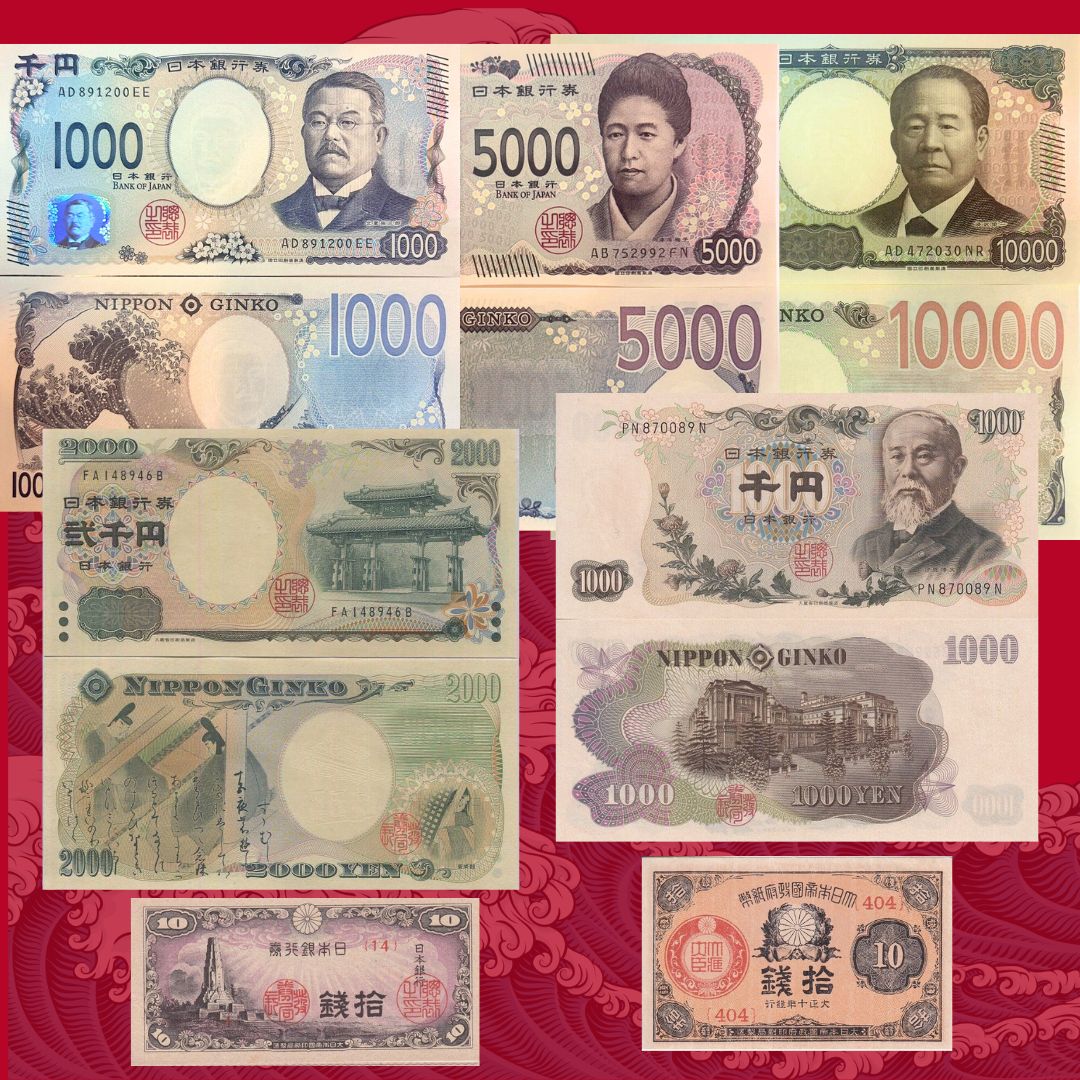Rare Japanese banknotes hold a special place in the hearts of collectors and numismatists worldwide. These historical pieces of currency not only offer a glimpse into Japan's rich cultural and economic history but also present a fascinating collecting challenge. With intricate designs, historical significance, and varying degrees of rarity, Japanese banknotes are a compelling addition to any collection.
Historical Context
Early Japanese Currency
Before the adoption of paper currency, Japan relied on a system of commodity money, including rice and precious metals. The first official Japanese banknotes, known as Meiji Tsuho, were introduced during the Meiji era as part of the country's modernization efforts.
Evolution of Banknotes in Japan
The evolution of Japanese banknotes reflects the nation's economic development and political changes. From the Meiji era through the Taisho and Showa periods, and even during World War II, Japanese banknotes have undergone significant transformations in design, security features, and issuance.
Types of Rare Japanese Banknotes
Old Meiji Era Banknotes
The Meiji era (1868-1912) marked the beginning of modern banknote production in Japan. These early banknotes are highly valued for their historical significance and unique designs.
Taisho Era Banknotes
Banknotes from the Taisho era (1912-1926) are notable for their artistic designs and the introduction of more advanced printing techniques.
Showa Era Banknotes
The Showa era (1926-1989) saw significant changes in banknote design, particularly during and after World War II. Banknotes from this period are prized for their historical context.
WWII Military Scrip
During World War II, Japan issued military scrip for use by its armed forces. These notes are rare and highly sought after by collectors.
Post-War Banknotes
Post-war banknotes, especially those from the early 1950s, are also of great interest to collectors due to their historical significance and limited print runs.

Banknote #1: Meiji Tsuho (1872)
Description and Design
The Meiji Tsuho, issued in 1872, is one of the earliest examples of modern Japanese banknotes. It features intricate designs with traditional Japanese motifs, reflecting the country's cultural heritage.
Historical Significance
These banknotes were part of Japan's efforts to modernize its economy and establish a standardized currency system. They played a crucial role in the country's transition from a feudal economy to a modern industrial state.
Rarity and Market Value
Due to their age and historical importance, Meiji Tsuho banknotes are extremely rare and highly valued by collectors. Their market value can vary significantly based on condition and provenance.
Banknote #2: Daikokuten 100 Yen Note (1916)
Description and Design
The Daikokuten 100 yen note, issued in 1916, features the image of Daikokuten, one of the Seven Lucky Gods in Japanese mythology. The design includes intricate patterns and security features that were advanced for its time.
Historical Significance
This banknote was issued during the Taisho era, a period of political and social change in Japan. It reflects the country's growing confidence and cultural pride.
Rarity and Market Value
The Daikokuten 100 yen note is rare due to limited print runs and its age. High-quality examples are particularly valuable, fetching high prices at auctions.

Banknote #3: Bank of Japan 200 Yen Note (1927)
Description and Design
The 200 yen note, issued in 1927, features a portrait of Prince Shōtoku, a prominent historical figure in Japan. The design is notable for its artistic quality and detailed engraving.
Historical Significance
This banknote was issued during a period of economic turmoil in Japan. It represents the country's efforts to stabilize its currency and economy during the early Showa era.
Rarity and Market Value
The 200 yen note is rare, especially in mint condition. Its historical significance and artistic design make it a prized possession for collectors.
Banknote #4: Greater East Asia War 10 Yen Note (1942)
Description and Design
Issued during World War II, the Greater East Asia War 10 yen note features imagery related to the Japanese war effort. It is a stark reminder of a turbulent period in Japan's history.
Historical Significance
These banknotes were used by Japanese forces and occupied territories during the war. They hold significant historical value and are a testament to the era's challenges and complexities.
Rarity and Market Value
Due to their association with World War II, these banknotes are rare and sought after by collectors interested in military history.

Banknote #5: Series B 1000 Yen Note (1950)
Description and Design
The Series B 1000 yen note, issued in 1950, features a portrait of Hideyo Noguchi, a famous Japanese bacteriologist. The design includes advanced security features and intricate artwork.
Historical Significance
This banknote was part of Japan's post-war economic recovery and stabilization efforts. It symbolizes the country's resilience and determination to rebuild after the devastation of World War II.
Rarity and Market Value
The Series B 1000 yen note is relatively rare, especially in high-grade condition. Its historical context and the prominence of Hideyo Noguchi add to its value.

Factors Determining Rarity and Value
Print Quantity
The number of banknotes printed significantly affects their rarity. Limited print runs result in higher scarcity and value.
Condition and Grading
The condition of a banknote, assessed through professional grading, is crucial in determining its market value. Well-preserved banknotes command higher prices.
Historical Context
Banknotes associated with significant historical events or periods are often more valuable due to their historical importance.
Collectors’ Demand
The demand among collectors can drive up the value of certain banknotes. Popular designs, historical significance, and rarity all contribute to demand.

Collecting Rare Japanese Banknotes
How to Start Collecting
Begin by researching and understanding the different eras and types of Japanese banknotes. Start with more accessible notes and gradually move to rarer pieces.
Tips for New Collectors
- Education: Learn as much as possible about Japanese banknotes and the history behind them.
- Networking: Connect with other collectors and join numismatic societies.
- Authentication: Ensure the authenticity of banknotes before purchasing.
Preservation and Storage
Proper preservation and storage are essential to maintain the condition and value of banknotes. Use acid-free sleeves and store in a climate-controlled environment.
Investment Potential
Long-term Value Trends
Rare Japanese banknotes have shown a steady increase in value over time, making them a viable investment option for collectors.
Expert Insights
Experts suggest that focusing on historically significant and well-preserved banknotes can yield substantial returns.
Risks and Considerations
Investing in rare banknotes involves risks, including market fluctuations and the potential for counterfeit notes. Thorough research and caution are advised.
Case Studies
Famous Collections and Auctions
Numerous famous collections and high-profile auctions have highlighted the value of rare Japanese banknotes. These events provide insights into market trends and collector preferences.
Notable Sales and Their Impact
Significant sales, such as rare Meiji era banknotes, have set records and influenced market values, demonstrating the high demand for these historical pieces.
Expert Insights
Interviews with Numismatists
Interviews with experienced numismatists offer valuable perspectives on collecting and investing in rare Japanese banknotes. They provide tips on identifying valuable notes and avoiding common pitfalls.
Advice from Seasoned Collectors
Seasoned collectors share their experiences and strategies for building a valuable collection. Their insights can guide new collectors in making informed decisions.
FAQs
Common Questions About Rare Japanese Banknotes
What makes a Japanese banknote rare? The rarity of a banknote is determined by factors such as print quantity, historical context, and condition.
How can I authenticate a rare Japanese banknote? Authentication can be done through professional grading services and by consulting experts in Japanese currency.
What are the most valuable Japanese banknotes? Banknotes from the Meiji, Taisho, and early Showa eras, especially those with historical significance, are among the most valuable.
How should I store my banknote collection? Store banknotes in acid-free sleeves and a climate-controlled environment to preserve their condition.
Conclusion
Collecting rare Japanese banknotes is a rewarding hobby that offers a window into Japan's rich history and cultural heritage. Whether you are a seasoned collector or a newcomer, understanding the factors that determine the rarity and value of these banknotes is essential. With proper knowledge and care, collecting these historical pieces can be both enjoyable and financially rewarding.

